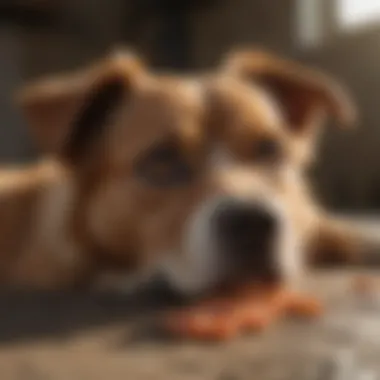Effective Strategies for Managing Hookworms in Dogs: A Comprehensive Guide


Animal Species Profile
In the realm of dogs, understanding the intricacies of hookworm infestations becomes paramount for responsible pet ownership. These parasites, often invisible to the naked eye, can wreak havoc on a canine's health if left unchecked. By delving into the world of hookworms in dogs, we equip ourselves with the knowledge necessary to safeguard our beloved companions from harm.
Symptoms of Infection
Unveiling the presence of hookworms in dogs is not always a straightforward task. Symptoms may range from subtle to debilitating, including lethargy, weight loss, diarrhea, and a dull coat. Detecting these signs early on can prompt timely intervention, preventing further complications and ensuring the well-being of our furry friends. Stay vigilant for any unusual changes in your dog's behavior or appearance to catch the infestation in its early stages.
Diagnostic Procedures
Navigating the maze of diagnosing hookworm infections requires precision and thoroughness. Veterinary professionals employ various methods, such as fecal examinations and blood tests, to confirm the presence of these parasites in a dog's system. Accurate diagnosis is key to formulating an effective treatment plan tailored to the specific needs of the infected canine.
Treatment Modalities
Once a diagnosis is established, initiating the appropriate treatment regimen is essential to combatting hookworm infestations effectively. Veterinary guidance is crucial in determining the most suitable approach, which may involve deworming medications and supportive care to address any secondary complications resulting from the presence of these insidious parasites.
Preventive Measures
In the realm of veterinary care, prevention often emerges as the adage
Understanding Hookworm Infections in Dogs
Understanding Hookworm Infections in Dogs is crucial for every pet owner, delving into the intricacies of this common yet potentially harmful condition. By comprehending the nuances of hookworm infections, individuals can better safeguard the well-being of their canine companions. This section serves as a cornerstone in the comprehensive guide, enlightening readers on the significance of early detection and management strategies for hookworms in dogs.
Overview of Hookworms
Hookworms, parasitic nematodes often found in dogs, present a serious health concern. The lifecycle of hookworms is intricate, involving stages that impact the host's health significantly. By grasping the nuances of the Lifecycle of Hookworms, readers gain insight into how these parasites sustain themselves and propagate within the host. This knowledge is fundamental for developing effective treatment and prevention strategies.


Lifecycle of Hookworms
The Lifecycle of Hookworms encompasses various stages, including egg, larva, and adult worm. Understanding these stages is paramount as it sheds light on how hookworms infest dogs and perpetuate infections. Awareness of the different developmental phases aids in identifying vulnerable periods for intervention and treatment.
Common Types of Hookworms in Dogs
Different species of hookworms infect dogs, with each type possessing unique characteristics and behaviors. Recognizing the Common Types of Hookworms in Dogs is vital in tailoring treatment approaches and understanding variances in symptoms. This section elaborates on key distinctions among hookworm species, equipping readers with valuable insights into these parasitic organisms.
Symptoms of Hookworm Infections
Detecting symptoms of hookworm infections is pivotal for timely intervention. Both Physical Signs and Behavioral Changes manifest in infected dogs, signaling varying degrees of infestation. By familiarizing themselves with these symptoms, dog owners can promptly seek veterinary care and minimize the impact of hookworms on their pets.
Physical Signs
Physical Signs of hookworm infections include anemia, gastrointestinal distress, and skin irritations. These manifestations offer visible cues of internal distress in dogs and prompt the need for diagnostic evaluation. Recognizing these physical indicators enables proactive measures to address the underlying parasitic infestation.
Behavioral Changes
Behavioral Changes in infected dogs encompass lethargy, changes in appetite, and altered activity levels. These behavioral shifts are subtle yet indicative of underlying health issues. Understanding these changes is essential for gauging the severity of the infection and tailoring treatment regimens to meet the pet's needs.
Diagnosing Hookworm Infections
Accurate diagnosis is paramount in effectively managing hookworm infections in dogs. Veterinary Examination and Fecal Tests play integral roles in confirming the presence of hookworms and assessing the extent of the infestation. Through meticulous diagnostic procedures, veterinarians can formulate targeted treatment plans for affected animals.
Veterinary Examination
Veterinary Examination involves physical assessments and medical history reviews to pinpoint potential sources of infection in dogs. This thorough evaluation aids veterinarians in developing treatment strategies tailored to the individual needs of each pet. Detailed examinations enhance diagnostic accuracy and guide treatment efficacy.
Fecal Tests


Fecal Tests are instrumental in detecting hookworm eggs or larvae in a dog's stool, providing definitive evidence of parasitic presence. By examining fecal samples under a microscope, veterinary professionals can identify specific hookworm species and determine the most appropriate course of treatment. Supplementing clinical evaluations with fecal tests bolsters diagnostic precision and treatment outcomes.
Treatment Options for Hookworm Infections
In delving into the complexities of treatment options for hookworm infections in dogs, a crucial aspect of this informative piece unravels. Understanding how to effectively combat hookworms is paramount for ensuring the well-being of our beloved companions. By focusing on specific elements such as medication and home remedies, this article aims to equip pet owners with the necessary knowledge to address the threat posed by hookworm infestations comprehensively.
Medications for Hookworms
Anthelmintic Drugs
Exploring the realm of anthelmintic drugs provides a deep insight into combating hookworm infections effectively. The key characteristic of these drugs lies in their ability to target and eliminate parasitic worms within the canine digestive system. Anthelmintic drugs stand out as a popular choice due to their proven efficacy in eradicating hookworms. Their unique feature lies in their direct impact on the parasitic organisms, leading to a notable reduction in worm burden. While anthelmintic drugs offer significant advantages in treating hookworm infections, it is essential to consider potential side effects and dosage precision to optimize their effectiveness.
Administration Guidelines
The administration guidelines for hookworm medications play a pivotal role in the successful treatment of canine infestations. These guidelines outline crucial parameters such as dosing frequencies, preferred administration routes, and potential interactions with other medications. Adhering to these guidelines is integral to maximizing the therapeutic benefits of the prescribed drugs. The key characteristic of administration guidelines lies in their ability to standardize treatment protocols, ensuring consistency and efficacy in combating hookworm infections. Following these guidelines diligently is a beneficial choice as it streamlines the treatment process and enhances the dog's recovery journey. However, it is imperative to be mindful of any potential drawbacks or contraindications associated with specific administration approaches to mitigate risks effectively.
Home Remedies and Care
Diving into the realm of home remedies and care unveils a holistic approach to complementing conventional treatments for hookworm infections in dogs. Emphasizing aspects like nutritional support and hygiene practices, this section aims to provide pet owners with additional tools to support their furry companions' recovery and well-being.
Nutritional Support
The incorporation of nutritional support into the treatment regimen serves as a cornerstone in promoting the dog's immune response and overall health during hookworm infection management. Nutritional support encompasses tailored dietary interventions that aim to bolster the canine's nutritional profile, enabling them to combat the parasitic invaders effectively. The key characteristic of nutritional support lies in its ability to address specific dietary deficiencies and enhance the dog's resilience against hookworm infestations. Opting for nutritional support is a beneficial choice as it synergizes with medical treatment, offering a comprehensive approach to tackling hookworm infections. Understanding the unique advantages and potential drawbacks of nutritional interventions is essential for maximizing their therapeutic impact.
Hygiene Practices
Integrating proper hygiene practices into the care routine of dogs grappling with hookworm infections is paramount for preventing reinfestation and safeguarding overall well-being. Hygiene practices encompass a range of measures such as regular cleaning of living spaces, sanitization of pet belongings, and meticulous waste disposal. The key characteristic of hygiene practices lies in their ability to create a clean and hygienic environment that deters the proliferation of hookworm larvae. Prioritizing hygiene practices is a prudent choice as it reduces the risk of reinfection and fosters a healthy living environment for both pets and owners. However, understanding the nuances of hygiene maintenance and being aware of potential challenges in implementation are crucial for ensuring efficacy and sustainability.
Follow-up Veterinary Care


Unveiling the realm of follow-up veterinary care sheds light on the post-treatment phase of handling hookworm infections in dogs. By emphasizing aspects like monitoring recovery progress and preventing reinfestation, this section underscores the importance of comprehensive care continuity to safeguard the dog's long-term health and well-being.
Monitoring Recovery Progress
Efficiently monitoring the dog's recovery progress post-hookworm treatment constitutes a critical component of ensuring treatment efficacy and detecting any potential complications promptly. The key characteristic of monitoring recovery progress lies in its ability to track the dog's response to treatment, identify improvements or setbacks, and tailor care interventions accordingly. Vigilantly monitoring recovery progress is a beneficial choice as it allows for early intervention in case of relapses or treatment inadequacies. Understanding the unique advantages and challenges associated with recovery monitoring is essential for fostering a seamless and successful recovery journey.
Preventing Reinfestation
Addressing strategies to prevent hookworm reinfestation is essential for sustaining the dog's health and minimizing the risk of recurrent infections. The key characteristic of preventing reinfestation lies in establishing proactive measures such as regular deworming schedules, environmental sanitization practices, and targeted parasite control. Prioritizing prevention strategies is a prudent choice as it mitigates the likelihood of reinfection and preserves the dog's overall well-being. However, navigating the intricacies of reinfestation prevention and adapting strategies to suit individual circumstances are crucial for optimizing effectiveness and long-term protection.
At a glance, preventing hookworm infections in dogs emerges as a pivotal facet in this comprehensive guide. When delving into the realm of environmental management, the focus narrows down on crucial elements such as regular cleaning and yard maintenance. Regular cleaning, a cornerstone practice, entails meticulous upkeep to thwart hookworm infestations. Its significance lies in eradicating potential breeding grounds for hookworms, bolstering the overall efficacy of preventive measures. The systematic approach of regular cleaning ensures a hygienic environment conducive to your canine companion's well-being. On the other hand, yard maintenance plays a vital role in curbing the spread of hookworms by addressing outdoor areas where dogs can come into contact with infective larvae. This practice underscores the need for maintaining clean, well-kept yards to minimize the risk of infection. Proper yard maintenance serves as a proactive strategy in safeguarding your pet's health. When shifting focus to deworming protocols, the discussion encompasses the frequency of deworming and veterinary recommendations. The frequency of deworming dictates the periodicity at which dogs should receive deworming treatments, aligning with optimal preventive practices. This proactive approach aids in mitigating the risk of reinfestation, ensuring continuous protection against hookworms. On the other hand, veterinary recommendations offer valuable insights into tailored deworming plans, taking into account individual dog characteristics and environmental factors. Following professional advice enhances the effectiveness of deworming efforts, promoting comprehensive protection against hookworms. Exploring hygiene practices for dog owners sheds light on essential habits like handwashing and proper waste disposal. Handwashing, a fundamental practice, holds the key to preventing the transmission of hookworm larvae between dogs and humans. Emphasizing thorough handwashing routines mitigates cross-contamination risks, fostering a hygienic environment for both pets and owners. On the other hand, proper waste disposal underscores the importance of disposing of dog feces responsibly to prevent environmental contamination. Adhering to proper waste disposal protocols minimizes the spread of hookworms, contributing to a cleaner and safer living environment for all. Implementing stringent hygiene practices equips dog owners with effective tools to combat hookworm infections, fortifying the well-being of their furry companions.
Caring for a Dog with Hookworms
Caring for a dog with hookworms plays a pivotal role in ensuring the health and well-being of our beloved canine companions. In this comprehensive guide on dealing with hookworms in dogs, the section dedicated to caring for a dog with hookworms sheds light on crucial elements that dog owners need to consider. By focusing on the specific needs and challenges that arise when addressing hookworm infestations, this segment emphasizes the importance of proactive care and monitoring.
Supporting Your Dog's Recovery
Comfort and Rest
Discussing the aspect of 'Comfort and Rest' within the context of supporting your dog's recovery is essential. The comfort and rest provided to a dog undergoing treatment for hookworms are fundamental to its overall well-being. Ensuring that the stressed immune system of the dog gets the necessary rest and relaxation aids in expediting the recovery process. The peaceful environment promotes healing and soothes the discomfort caused by the infection, making it a popular choice for effectively managing hookworm infestations.
Monitoring Appetite
Exploring the facet of 'Monitoring Appetite' is crucial in understanding your dog's recovery journey. Monitoring your dog's appetite post-treatment for hookworms is vital to gauge its recovery progress and ensure adequate nutrition intake. By observing changes in appetite, one can identify any underlying issues or setbacks in the recovery process. Keeping a close eye on your dog's eating habits allows for immediate intervention if appetite changes are detected, contributing significantly to the successful management of hookworm infections.
Consulting with Your Veterinarian
Treatment Adjustments
Delving into 'Treatment Adjustments' underscores the significance of adapting treatment plans to suit the individual needs of the dog. Making necessary modifications based on the dog's response to medication or changes in symptoms enhances the efficacy of the treatment regimen. This personalized approach ensures that the dog receives optimal care tailored to its unique requirements, making it a valuable choice in optimizing treatment outcomes.
Emergency Situations
Analyzing 'Emergency Situations' highlights the critical nature of timely and decisive actions during unexpected health crises. Being prepared for emergencies related to hookworm infections can be life-saving for your dog. Recognizing alarming symptoms and knowing how to respond swiftly can mitigate risks and prevent serious complications. Understanding the protocols for handling emergencies equips dog owners to tackle unforeseen challenges effectively, making it an indispensable aspect of caring for a dog with hookworms.







